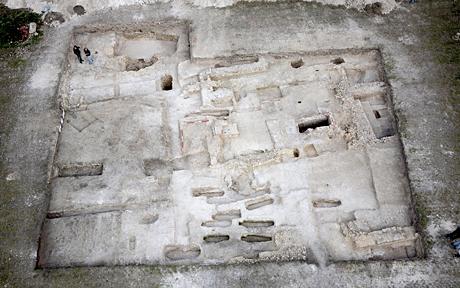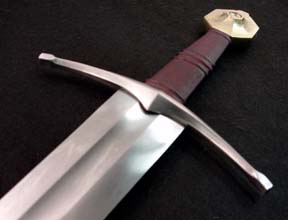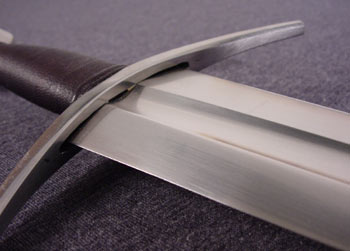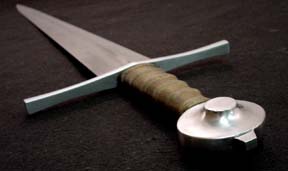 Saturday - February 26, 2011
Saturday - February 26, 2011
North By North South?

Sometimes I swear news stories are published just to scare people. Or to annoy those of us who can actually think. The magnetic north pole has ALWAYS been moving. As nifty as compasses seem when you’re a kid in Scouts, they all have this bit of inaccuracy built in. The truth is that they don’t actually point north. Or to the north pole. Or even to the magnetic north pole. The truth is that the compass needle aligns itself with the local magnetic field, a bit like a homing pigeon flying along a local ley line. And - no shir, Shitlock - those local field lines are not now, nor have they ever been, entirely parallel to the magnetic axis. This is what “magnetic declination” is all about. It’s also what you can avoid by having a GPS, or a device that has one built in. Like an iPad app. In the bad old days, we had to have paper maps available and know how to read them, and how to adjust them. The declination amount was shown at the top of the map. Yeah, an old map would have the wrong value, so you had to get new maps every decade or so. Big deal.

Ordinary Compasses Thrown Off by Changes in Earth’s Magnetic Field
The Earth’s magnetic field is changing at an increasing rate, throwing off airports and altering the aurora borealis—and its effect on ordinary compasses could mean the difference between homeward bound and hopelessly lost.
Earth’s northernmost magnetic point—or magnetic north—is distinct from its geographic North Pole, and scientists have long known that the magnetic poles are on the move.
But the magnetic poles have been moving faster lately, sliding towards Siberia at 34 miles per year at a speed that’s accelerated 36 percent over the last 10 years, according to the United States Geological Survey, or USGS.
Since compasses rely on magnetic north to point you in the right way up the trail, the average $2-dollar model could very well point you in the wrong direction. Depending on location and journey length, unaware hikers or boaters could find themselves hundreds of miles off course if they don’t calibrate for the shift, experts said.
Don’t forget that every once in a geologic while, the magnetic poles actually reverse themselves. It’s always been like that. And unless I missed the fine print statement that says how this is a magical and instantaneous shift, my understanding is that the magnetic pole goes from up to down by moving a little bit all the time.
And just for gits and shiggles, this Scary Science article above forgets to point out one salient fact: the magnetic north pole is moving northward over time:

which means that compasses are actually getting more accurate for most of us, because the distance between the magnetic north pole and the rotational north pole is decreasing. The magnetic pole is not moving directly towards the rotational pole, but it’s many many hundreds of miles closer to it than it was a century ago. See here for more movement history. And don’t let science stories scare you. Half the time they’re pure crap.
For extra fun, know that the movement of the magnetic poles is most probably caused by movement within the molten core of the planet. “Core Flux”. Vast continental sized plumes of molten iron rising and falling and swirling around. That’s the accepted theory it seems. Yet somehow that more energetic core moving about, sometimes closer to the surface, sometimes further away, that vast and incomprehensibly large mass of molten iron sometimes hotter or cooler ... has no impact whatsoever on the temperature of the surface just 50 miles or so above it. No, it’s a microminimal change in the amount of a rare atmospheric gas that causes the surface temperature variations. Uh huh. Right.
Posted by Drew458
Filed Under: • Amazing Science and Discoveries • Media-Bias •
• Comments (9)
 Friday - January 21, 2011
Friday - January 21, 2011
Romulan Technology Here On Earth
Led by mechanical science and engineering professor Nicholas Fang, Illinois researchers have demonstrated an acoustic cloak, a technology that renders underwater objects invisible to sonar and other ultrasound waves.
“We are not talking about science fiction. We are talking about controlling sound waves by bending and twisting them in a designer space,” said Fang, who also is affiliated with the Beckman Institute for Advanced Science and Technology.
The cloak is made of metamaterial, a class of artificial materials that have enhanced properties as a result of their carefully engineered structure. Fang’s team designed a two-dimensional cylindrical cloak made of 16 concentric rings of acoustic circuits structured to guide sound waves. Each ring has a different index of refraction, meaning that sound waves vary their speed from the outer rings to the inner ones.
“Basically what you are looking at is an array of cavities that are connected by channels. The sound is going to propagate inside those channels, and the cavities are designed to slow the waves down,” Fang said. “As you go further inside the rings, sound waves gain faster and faster speed.”
Since speeding up requires energy, the sound waves instead propagate around the cloak’s outer rings, guided by the channels in the circuits. The specially structured acoustic circuits actually bend the sound waves to wrap them around the outer layers of the cloak.
The researchers tested their cloak’s ability to hide a steel cylinder. They submerged the cylinder in a tank with an ultrasound source on one side and a sensor array on the other, then placed the cylinder inside the cloak and watched it disappear from their sonar.
The cloaking technology also may affect nonlinear acoustic phenomena. One problem plaguing fast-moving underwater objects is cavitation, or the formation and implosion of bubbles. Fang and his group believe that they could harness their cloak’s abilities to balance energy in cavitation-causing areas, such as the vortex around a propeller.
Pretty awesome. Read the rest. If this gizmo can eliminate vortex cavitation it will massively enhance ship’s efficiency. More knots per nuke, or whatever mpg ratings submarines and surface ships use.
I’m also wondering how this technology, once mature, can be applied to ordinary things like speaker boxes and car bodies. Or hotel room walls, or as a slip-on acoustic barrier for noisy children in the grocery store or in restaurants. Oh hella yeah! The all new Scream Screen™ by Fisher Price. Must. Have. Soonest!!
Posted by Drew458
Filed Under: • Amazing Science and Discoveries •
• Comments (0)
 Wednesday - December 29, 2010
Wednesday - December 29, 2010
Stoners For Global Warming?
Like, wow man, the total irony.
I was bopping through the news this morning, looking for something interesting to post on, when I found an article at FoxNews on indoor gardening.
How to Build a High-Tech Indoor Garden This Winter
The dark days of winter are upon us, but that doesn’t mean you have to give up on gardening until the spring. Grow lamps are becoming increasingly popular in gardening circles these days. And new breeds of low-power lights make them affordable options for those looking to keep a kitchen stocked with green herbs through the winter months, or those just looking to jump start their seedlings for next spring.
Before going any further, we need a quick scientific crash course. Plants need fairly intense light to grow, and the intensity of light in measured in a factor called lumens. The higher the lumen value of a bulb, the stronger the light and the better your plants will grow. For noticeable growth, you’ll want a bulb that puts out at least 4,000 lumens, and some bulbs can produce upwards of 40,000 lumens.
But a light’s intensity isn’t the only thing you have to look for; the temperature of the light is also important, a value measured in kelvins. Temperature in this case refers to the color of the light: the bluer, or colder the light, the higher the kelvin value. The warmer, or redder the light, the lower the value.
... and so on. Who is he kidding? And how did this article sneak in? It’s instructions on how to build a grow room. For your flowers, of course. And your “green herbs”. Uh huh. He goes on a bit about the different kind of bulbs out there and how well they work for growing plants. Incandescent (very poor), fluorescent (poor), etc., up to HID lamps (awesome). I think he wanted to write that the newest LED bulbs were the be-all and end-all, but they aren’t. Not yet. They don’t use much electricity, and they can be built to emit specific frequencies of light, but they simply don’t put out anywhere near enough light. And yet ... neither this author nor any other has really taken a look at the latest generation of Cree LEDs. I think they are the wave of the future, but the thing about the future is that it isn’t here yet.
What is the Cree LED? This is not the little red light on your coffee pot. These little 1/4” bitches are awesome! They generate an extraordinary amount of light. I’ve got a digital flashlight that uses one of them, and at the two highest settings it’s a weapon. The painfully bright light will shut your eyes down, causing near temporary blindness. 630 lumens for several hours from 8 AA batteries. Other flashlights drive these LEDs even harder, and produce 900-1000 lumens but with shorter battery life. Imagine a few of these as reflector lamps run off of low voltage transformers. Still, even 630 lumens - about the same light output as a regular 40 watt lightbulb - from something the size of the head of a carpet tack, that needs only 12 volts, is might impressive. 16 of them on a 1” square lamp would light up a barn while using perhaps 32 watts of electricity.
[ HUGE amounts of redacted writing here, as Drew decided he didn’t really want this post to be a lesson on how to build a grow room and a step by step guide to light usage, placement, intensity, and purpose over the life cycle of short season plants. Like those “green herbs”. Uh huh. ]
Once upon a time this was all semi-secret underground information. But thanks to the internet, today it’s just a mouse click or two away, and you can read all sorts of scientific papers on indoor gardening, starting with the original ones, done by the Department of Defense back in the late 50s, who envisioned vast underground bunkers filled with people waiting for the Nuclear Winter to end and the post-apocalyptic radiation levels to fall, and knew that those people would need to eat. So they went out and figured out just what kind of light, how much and how many hours of it per day, what ambient temperature, what N-P-K soil additives, and even what CO2 levels would produce the most efficient plant growth. Many other studies have been done since then, and now all sorts of data is easily available.
What about the stoners dude?
You can’t spend very much time looking up information on building an indoor greenhouse before you run across carbon dioxide. It’s the greenhouse gas you want in your greenhouse. Plants breath the stuff, duh. And a good greenhouse is a fully controlled environment, right down to the air itself. And ... surprise, surprise! ... it turns out that plants LOVE CO2! They adore it. Hell, they literally live for it. And study after study after study shows that significantly higher levels of the stuff promotes plant growth. Those studies also show that when the CO2 levels get really high, plants need higher temperatures to get the most out of it. And more light and water too, and eventually more fertilizer. A rich moist brilliant almost-hot hothouse environment.
Currently, the most recent CO2 level measurement from Hawaii is 388.59 PPM. For optimum plant growth, the ideal indoor greenhouse level is 1500 PPM, more than 4 times higher than current world conditions. In regular sunlight, plants really want levels 5 times higher than what’s outside. 500% more. Just to attain their full potential. Other studies have shown that plants can live in atmospheres with as much as 10,000 PPM of CO2, even though levels over 2500 PPM are lethal for people.
This is pretty much common knowledge across dozens, if not tens of thousands, of Grow Pot In Your Closet websites. And just as many nominally upstanding horticultural ones, a few of which I’ve linked to in this post.
So there it is, in digital black and white. The truth is out there. More carbon dioxide plus warmer temperatures equals more plant growth. More plant growth equals higher crop yields. Left leaning stoner hippies already know this, and go to great lengths to make it happen for their crop of bud. Higher crop yields mean more food ( or more “green herbs” ) for more people. More food for more people means less hunger and starvation. So why is anyone unhappy about a possible slight increase in global temperatures or CO
Posted by Drew458
Filed Under: • Amazing Science and Discoveries • Climate-Weather •
• Comments (6)
 Tuesday - December 28, 2010
Tuesday - December 28, 2010
unveiled, a 1-000-core-chip- will-make-desktop-machines-20-times-faster
Some headlines from the papers today and this one should interest the more tech savvy among you. Although all of us will always welcome faster PCs, isn’t there more to it? Your ISP for example. I read that some are faster then others.
What I can’t figure out at the moment is, if you have say EARTHLINK (ELNK) but AT&T owns the line being used, what might make ELNK any faster then AT&T?
And if there’s something they are using to make them faster, then why wouldn’t the ISP who owns the line have the same technology?
But the biggest wow thing I’m trying to understand is ... 1,000 cores? OK, in less then a thousand words, what’s a core when we’re speaking of computers?
Can’t mean the same as the word implies, does it? But a thousand of em? See? I’m always awed by stuff I hardly understand. Some ppl understand things instinctively, while the rest of us mortals must plod and scratch our heads and try harder. And feel not too bright. Sort of like a flickering light or maybe no light at all.
Scientists unveil chip which could make desktop computers 20 times fasterBy Daily Mail Reporter
Last updated at 11:01 AM on 28th December 2010

Scientists have created an ultra-fast computer chip which is 20 times faster than current desktop computers.
Modern PCs have a processor with two, four or sometimes 16 cores to carry out tasks.
But the central processing unit (CPU) developed by the researchers effectively had 1,000 cores on a single chip.
The developments could usher in a new age of high-speed computing in the next few years for home users frustrated with slow-running systems.
The chip was able to process around five gigabytes of data per second in testing - making it approximately 20 times faster than modern computers.
The team was led by Dr Wim Vanderbauwhede, of the University of Glasgow, and colleagues at the University of Massachusetts Lowell.
The research scientists were able to make the processor faster by giving each core a certain amount of dedicated memory.
Dr Vanderbauwhede said: ‘This is very early proof-of-concept work where we’re trying to demonstrate a convenient way to program FPGAs so that their potential to provide very fast processing power could be used much more widely in future computing and electronics.
‘While many existing technologies currently make use of FPGAs, including plasma and LCD televisions and computer network routers, their use in standard desk-top computers is limited.
I wasn’t going to post as much of that story above as I did, but as Drew can tell ya, I tend to get quite wrapped up in things I’m not intended by nature to get wound up in. Thing is, I really love that stuff. It’s kind of like being in love with an unfaithful mistress. Not that I have any experience with that either.
The other headline I thought I’d bring to our attention is:
The Big Thaw begins: Relief for Britons as Arctic air is replaced by balmy 12C breezes… but you’ve not seen the last of the snow
· December set to be coldest ever - a degree colder than previous record
· Fears ‘quick melt’ could lead to flooding in parts of the country
Not too bad today altho very misty and gray. And cold. No, not a bad day at all when I think of humid summers and no air cond.
Posted by peiper
Filed Under: • Amazing Science and Discoveries • Neat Inventions • UK • USA •
• Comments (7)
 Monday - December 20, 2010
Monday - December 20, 2010
awesome advance in help for the blind, bionic eye surgery
Not certain but, it appears to be another notch in the record books for German science, but Brits first to have “permanent” fix. Whatever ... this is really a super duper giant step for mankind. Or should that be personkind?
British doctors to implant first permanent ‘bionic’ eyes that will allow the blind to ‘see’By Daily Mail Reporter
Last updated at 4:16 PM on 20th December 2010Blind British patients will be the first in the world to have permanent ‘bionic’ eyes inserted that will allow them ‘see’ for the first time.
The revolutionary microchip was first tested on three patients in Germany earlier this year and yielded dramatic results. One man saw his girlfriend’s smile while another was able to read his name.The chip was taken out after three months but medics at King’s College in London plan to implant them for life, after scientists developed a new coating which is safer for permanent use.
The hospital will begin testing the tiny microchip in March and is one of two British centres now recruiting people to trial the device hailed as ‘quite astonishing’ by experts.It is packed with 1,500 light sensors designed to replace those in the retina lost to the most common form of eye disease, retinitis pigmentosa.
The inherited condition gradually destroys the light sensitive retina at the back of the eye, causing blindness.

Surgeon Tim Jackson will head the trials at King’s. The consultant said: ‘The results demonstrated by the German team represent an important step towards an artificial vision that could greatly enhance the quality of life for people with an incurable, blinding disease. It is unquestionably an extremely exciting development.’
Bionic eyes have been piloted before. But this battery-powered implant is the first not requiring cumbersome accessories such as a camera mounted on dark glasses.
The implant is three millimetres square. It is fitted with sensors which trigger an electronic pulse.
This pulse stimulates nerves leading to the brain enabling patients to see a rough black and white image.
German firm Retina Implant AG which is behind the implant hopes it will become widely available within five years.
Posted by peiper
Filed Under: • Amazing Science and Discoveries • OUTSTANDING ACHIEVEMENT •
• Comments (1)
 Friday - November 19, 2010
Friday - November 19, 2010
A Star Trek-style device that allows people to disappear.
How’s this for an eye opener?
Not up to much today, but don’t want to ignore this one. Think of the possibilities.
Star Trek-style cloaking device comes a step nearerA Star Trek-style device that allows people to disappear and then – in a blink of an eye – reappear in a different location is a step closer to reality, claim British scientists.
By Richard Alleyne, Science Correspondent
The physicists claim they have proved that it is possible to manipulate space and time so that whole events are hidden from view.
That means eventually that someone could be made to look like they jump from one location to the next – with the journey in-between rendered invisible to the naked eye.
The “space time cloak” uses physics to manipulate light so that “events” in real life are cut just like an editor can cut scenes from a reel of film.
The device sounds like the stuff of fantasy, but scientists at Imperial College London have proved it could work in theory – at least in terms of very short bursts of time.
As well as being a sci-fi fan’s dream, they believe the idea could also be used to make faster and more powerful computers.
Professor Martin McCall, the lead scientist, said that the technique worked by dividing up rays of light that are heading towards the eye.
By speeding up the front part of the ray and then slowing down the rear, you can create a gap which could be filled with an event or action.
Then by reversing the speeds the gap could be closed again before the light reaches the observer making it look nothing has happened.
At the moment it should be possible to cut two thousandth of a millionth of second from time but in future seconds or even minutes could be cut.
“Imagine a camera that is on a time delay watching a safe,” said Prof McCall. “If a thief opens the safe, steals the money and locks it again in between the pictures being taken it will appear as if nothing has happened.
“We have shown that by manipulating the way the light illuminating an event reaches the viewer, it is possible to hide the passage of time in the same way.
“If you had someone moving along the corridor, it would appear to a distant observer as if they had relocated instantaneously, creating the illusion of a Star Trek transporter.
“So, theoretically, this person might be able to do something and you wouldn’t notice.”
In previous experiments to create “invisibility cloaks” scientists have shown that light can be curled around objects to make them seem invisible.
The teleporters used in Star Trek are said to have been based on the idea of “quantum entanglement” in an object or person is broken down into photons of light or atoms, transported and then re-materialised in a different place.
This new technology would not actually transport anyone just hide their journey.
Researcher Alberto Favaro said: “It is unlike ordinary cloaking devices because it does not attempt to divert light around an object.
Posted by peiper
Filed Under: • Amazing Science and Discoveries • Science-Technology •
• Comments (1)
 Wednesday - November 10, 2010
Wednesday - November 10, 2010
Shoulda Known
Looks like that “mystery missile” the other day was actually USAirways flight 808 inbound from Hawaii.
Yep, that fits.
Link here, with the math. Link here, to the source with the nice multi-part graphic at the bottom.
Nice work Liam Bahneman, doing some actual investigative journalism, checking the flight itineraries, and looking up a Newport Beach webcam the day after to see that the same flight the very next day made almost the same kind of contrails in the sky.
Now, I wonder how many days it will be until the TV news folks catch up to this, and stop pushing the sensationalist story now that it’s been figured out. If you are directly under the flight path of a very high altitude jet flying over you through dirty air, the contrails in the sky look just like those of a rocket heading straight up.
And I sure do wish that there was an actual video of an actual missile or space rocket launch, at sundown, photographed from just over the horizon. How are we supposed to tell them apart? Especially since no rule says a shorter range missile has to be supersonic, which means you can’t use your ears to tell impending doom from just another jet going over. I followed the math at the first link, and I still can’t tell the difference; a multi-stage missile could drop it’s booster stage before it cleared the visual horizon. So when an object is too high to see or hear but is creating a visible contrail, how can you tell up from over since they both appear the same? The only way I can figure is to jump in your car, drive several miles, then look again. Assuming that it wasn’t an inbound missile and that you haven’t become a monatomic smithereen ( which would answer the question! ), when you look at the same contrail from the new location it will now have a definite “going over” aspect if it’s from a jet. I’m guessing here, purely guessing, but if it’s a missile launch you’re seeing, it will still look like “up” even from “over there”.
The Newark to Chicago flight passes almost overhead here. So do the New York and Boston to points southwest flights. On a clear day I can count the number of engines and see the airplane itself. The contrails never roil together, nor is there any kind of “plume of fire” behind the jets. But they always look like planes flying overhead, not rockets shooting up. On a cloudy day I can’t see anything anyway, so who cares? We don’t have LA’s level of air pollution, and we don’t have coastal wind and cloud patterns. And we don’t have a distant horizon for the sun to set into. Those factors could make all the difference.
Posted by Drew458
Filed Under: • Amazing Science and Discoveries • News-Briefs • planes, trains, tanks, ships, machines, automobiles •
• Comments (1)
 Thursday - October 21, 2010
Thursday - October 21, 2010
another great find …. this one’s for me and Drew but ur all welcome to join the club …..
Winchester is not that big a place, and I admit I don’t get out as much as I once did. Besides, it’s freezing cold at the moment. Even so, if I knew where in Winchester this was, I’d be dragging myself out. But where in Winchester? The article appeared in the Telegraph, but not our weekly local newspaper which publishes on Thursday. Today. Judging by the photograph, they must have been working on this for awhile as it looks fairly clean. WOW! How do things last this long? I’d love to know where this is exactly. Tomorrow morning ... phones calls .... WOW!
Britain’s first hospital discovered
A site which may house Britain’s earliest known hospital has been uncovered by archaeologists.

The excavations have revealed a range of buildings and convincing evidence for a foundation in the 10th century
Radio carbon analysis at the former Leper Hospital at St Mary Magdalen in Winchester, Hampshire, has provided a date range of AD 960-1030 for a series of burials, many exhibiting evidence of leprosy, on the site.
A number of other artifacts, pits, and postholes also relate to the same time including what appears to be a large sunken structure underneath a medieval infirmary.
Before this new claim, most historians and archaeologists thought that hospitals in the Britain only dated from after the Norman conquest of 1066.
‘’This is an important archaeological development,’’ said Dr Simon Roffey from the University of Winchester which conducted the dig.
‘’Historically, it has always been assumed that hospitals were a post-conquest phenomena, the majority founded from the late 11th century onwards.
‘’However, our excavations have revealed a range of buildings and, more significantly, convincing evidence for a foundation in the 10th century.
‘’Our excavations at St Mary Magdalen offer an intriguing insight into a little known aspect of the history of both Winchester and England. It is undoubtedly a site of national importance.’’
Among the earliest known hospitals in the UK is Harbledown in Canterbury founded by Lanfranc in the 1070s, following the Norman Conquest.
Professor Nicholas Orme, a leading researcher on medieval hospitals, added: ‘’I have only studied the documentary evidence but I could not find any such evidence for a hospital before 1066 except perhaps as an activity within a monastery or minster.
‘’A late Anglo-Saxon hospital would surely be a first for archaeology and indeed for history.’’
Winchester was the capital of England throughout a large part of the Anglo-Saxon period and after the Norman Conquest. The capital was moved to London from the Hampshire city in the 12th century.
Posted by peiper
Filed Under: • Amazing Science and Discoveries • Archeology / Anthropology • UK •
• Comments (0)
 Wednesday - October 20, 2010
Wednesday - October 20, 2010
Where ya bin?
Not much posting from me the past few days. What time I’ve had for internet surfing has been eaten up studying. Yeah, I went down another one of those digital tangents, and got deep into some seriously esoteric knowledge. It happens.
It all started when I read something about some Viking raid back in the late Dark Ages. And the memory that those guys used something called a “klondorf” sword popped into my head. And that got me Googling. Well, it turns out that it wasn’t “klondorf” it was “clontarf”, named after a long ago battle in Ireland in which the Vikings got whupped but good.

I was pretty amazed that the minute by minute details of that battle were still known, along with all the political squabbling, temporary alliances, and dirty deeds that lead up to it. It’s a colorful story in the best Irish tradition, and in the end there are no real winners. Oh sure, the battle itself was quite decisive. But afterwards the folks went right back to squabbling and dirty dealing, so nothing was really gained by it.
But it made me think of just how courageously mad and how physically strong these warriors must have been to go at it in the dirt with these massive choppers, protected by little more than a leather shirt and a wooden shield. So I looked into it, and found out some things that I thought were very interesting. And that’s when I got on the Express Bus to ride down Esoterica Street.
For starters, swords were much lighter than I realized. I was a fencer in college, and the foils, epees, and sabres we used all weigh only a few ounces. A pound at most, IIRC. That doesn’t count; that’s modern sporting equipment. But I’ve got some sort of cultural memory, fueled by Bugs Bunny cartoons and Errol Flynn movies in which the plucky princess can barely lift a sword in emergency circumstances to save her own honor ... these things had to weigh a ton, yes? No. Surprise! A broadsword, any broadsword, from the early kind the Vikings used right up until they went away in the early days of the Renaissance, only weighed about 2 1/2 pounds. The seriously huge ones, like the double handed Claymores, only weighed a pound more. Nor were they point heavy imbalanced cudgels; thousands of ancient swords are still around, and almost all of them balance within a hand-span of the hilt. And they were sharp. We tend to denigrate the skills of the ancients these days, poo-pooing their feeble efforts in just about everything. But we are wrong to do so. Vainglorious. These guys may not have turned out 5000 tons of chromaloy steel a day like today’s mills, but what they wrought, they wrought well.
Another thing that really caught me off guard was the flexibility these blades had. I’d never really thought about it, but if anything, I’d figured that they were all stiff as rocks; great clanging iron I beams with a bit of a sharp edge. Wrong again Sherlock. A properly tempered broadsword can flex nearly 90 degrees and still not take a bend. Try that with your fancy kitchen knives! This is a very long way from the smithing process used to make the Roman Gladius, which was a short sword that was very stiff. That one was built up out of bars of twisted wrought iron hammer forged together ... go and read Jack Whyte’s Camulod Chronicles series of novels for a very detailed explanation of that process ... plus it’s a great read, and a wonderful telling of the “coulda been” story of the shaping of early Britain behind the Arthurian legend. Well, read the first 6 novels in the series. The last few books aren’t as good; the series really ought to have ended with Metamorphosis with young Arthur, the newly crowned Christian high king, rushing off to his first major battle, Excalibur in hand.
Then I found out that the evolutionary history of edged weapons has been classified by this guy Ewert Oakeshott, who spent the better part of his life studying the things, and developed the typology used by everyone today that shows the kind of swords used, who use them, where, and when. He figured out the arms race of those days, how swords grew and changed across the centuries in response to different armor, different metallurgy, and different ways of fighting wars. Impressive as all get out, and about as esoteric a field of expertise as you could ever hope to find. Which makes it pretty obvious he was an Englishman. Well done, that man.
But I was still interested in the metallurgy aspect. The mining, the smelting, the smithing. I’m still looking into that, still learning. And I think this is the core issue that marks the difference between western swords, those knightly weapons of the Middle Ages, and their counterparts in the Far East, the Katana blades of the samurai. Europe has had iron mines since forever. And coal. And may have had coke ( as charcoal is to wood, coke is to coal ) in small quantities for a very long time. But when they smelted iron their results had either no carbon (wrought iron) or too much carbon (cast iron), and very little steel (just a bit of carbon). Ancient Japan got most of its iron ore from the beaches. They have iron sands. And no coal. So their smelting was done at a much lower temperature, which gave them a non-homogeneous result, but that mixed result had both kinds or iron and both low and high carbon steel in it. This in turn forced the smiths to take an entirely different path to smithing and making weapons. That lead to all that hammering and folding, that near-mythical forging knowledge and level of labor that was required to build those fabled blades. ( for a great, lengthy, but simple read on the history of Japanese steel making, read this. ) Following that path for a bit I learned that a typical Katana was just about the same size and weight as it’s European counterpart, but with a shorter, heavier, but equally flexible blade. Because it was made from mixed steels. And they had a much more forward weight balance, due to their long two-handed grip and not much in the way of a pommel. I had always thought things were exactly the opposite, that samurai swords were the utter peak of the swordsmith’s art in all things, balance included. Horrible snark opportunity: different strokes for different folks!

Tamahagane steel is made by building and firing a Tatara, the traditional Japanese sword-steel smelter. This charcoal- fired furnace produces a very pure steel from iron sand, and this steel ‘’Kera’’ or bloom can be broken and separated into high- and low-carbon pieces, which respectively form the ‘’skin’’ steel and ‘’core’’ steel of the blade. The skin steel is forged and folded repeatedly, to remove slag inclusions and voids and is then wrapped around the core steel before the resulting billet is forged into a blade. Careful heat treating, shaping and polishing reveals the tight ‘’Hada’’ or layer pattern of the blade and the white particles of the ‘’Hamon’’ or temper line. While this process results in the aesthetic qualities much admired by collectors it also produces a very functional blade, as the high carbon content of the skin steel makes a very hard edge possible while the softer core steel gives the blade its resilience and ability to absorb shock.
I took a left turn somewhere along this road and delved into modern swords. Yes, they are out there, and not just the wall hanger bit of crap you can pick up for $24.95 at the mall and use to impress your drunken friends with when cutting watermelons. No, I’m talking real swords. Razor sharp lengths of properly forged and tempered steel, built to slice off heads, chop through chainmail and stab through armor plate. Battle ready weapons, modern heirlooms. Toys for boys with way too much money. Swordmaking is not a lost art; the best of today’s swords are every bit as good as the ones built 600 years ago. Better perhaps, although the very best ones strive to be as authentic as possible, which can mean making a slightly lesser weapon than what current technology could actually produce. They come in every shape and variety and at every price point. So do samurai swords. But eastern or western, the real real deal will set you back between nearly one and a bit more than two thousand dollars.







I simply can not make up my mind. They’re all favorites!
Not that I have the cash to waste on toys like these. But it’s tempting. They speak to me. They call to me.
Posted by Drew458
Filed Under: • Amazing Science and Discoveries • Fun-Stuff • History •
• Comments (1)
 Tuesday - October 05, 2010
Tuesday - October 05, 2010
Parisian apartment containing €2.1 million painting lay untouched for 70 years. most unusual
A very unusual story found in the morning paper. See what you think. I think it’s the most unusual article I’ve come across since joining BMEWS and sharing stories.
It reminds me in a way, of the movie, Somewhere In Time. The article said nothing about the background of the owner, or why she never moved back.
There’s so many questions.
She continued paying rent on an apartment in Paris for 70 years but never moved back into it. Why? Too late to ask now.
The painting mentioned must come to over two million dollars. I have not bothered to do any conversion from euros to dollars, but 2m in euros is surely more then 2m in $.
Take a look.
For 70 years the Parisian apartment had been left uninhabited, under lock and key, the rent faithfully paid but no hint of what was inside.
By Henry Samuel in ParisBehind the door, under a thick layer of dusk lay a treasure trove of turn-of-the-century objects including a painting by the 19th century Italian artist Giovanni Boldini.

FROZEN IN TIME ... THE PARIS FLAT THE WORLD LEFT BEHINDThe woman who owned the flat had left for the south of France before the Second World War and never returned.
But when she died recently aged 91, experts were tasked with drawing up an inventory of her possessions and homed in on the flat near the Trinité church in Paris between the Pigalle red light district and Opera.
Entering the untouched, cobweb-filled flat in Paris’ 9th arrondissement, one expert said it was like stumbling into the castle of Sleeping Beauty, where time had stood still since 1900.
“There was a smell of old dust,” said Olivier Choppin-Janvry, who made the discovery. Walking under high wooden ceilings, past an old wood stove and stone sink in the kitchen, he spotted a stuffed ostrich and a Mickey Mouse toy dating from before the war, as well as an exquisite dressing table.
But he said his heart missed a beat when he caught sight of a stunning tableau of a woman in a pink muslin evening dress.
The painting was by Boldini and the subject a beautiful Frenchwoman who turned out to be the artist’s former muse and whose granddaughter it was who had left the flat uninhabited for more than half a century.
The muse was Marthe de Florian, an actress with a long list of ardent admirers, whose fervent love letters she kept wrapped neatly in ribbon and were still on the premises. Among the admirers was the 72nd prime minister of France, George Clemenceau, but also Boldini.
The expert had a hunch the painting was by Boldini, but could find no record of the painting. “No reference book dedicated to Boldini mentioned the tableau, which was never exhibited,” said Marc Ottavi, the art specialist he consulted about the work.
When Mr Choppin-Janvry found a visiting card with a scribbled love note from Boldini, he knew he had struck gold. “We had the link and I was sure at that moment that it was indeed a very fine Boldini”.
He finally found a reference to the work in a book by the artist’s widow, which said it was painted in 1898 when Miss de Florian was 24.
The starting price for the painting was €300,000 but it rocketed as ten bidders vyed for the historic work. Finally it went under the hammer for €2.1 million, a world record for the artist.
“It was a magic moment. One could see that the buyer loved the painting; he paid the price of passion,” said Mr Ottavi.
Posted by peiper
Filed Under: • Amazing Science and Discoveries • News-Briefs •
• Comments (1)
 Wednesday - September 22, 2010
Wednesday - September 22, 2010
Turning Fire Green
Clinton to unveil US funds for clean cookstove push
Secretary of State Hillary Clinton will announce on Tuesday a U.S. contribution of more than $50 million toward providing clean cooking stoves in developing countries to reduce deaths from smoke inhalation and fight climate change.
The U.S. funding, which will be spread over five years, is part of a Global Alliance for Clean Cookstoves being started to combat a problem officials equate with malaria and unclean water in terms of their health impact worldwide.
Some 1.9 million premature deaths, mostly among women and young children, occur every year due to smoke inhalation from rudimentary stoves, which in many cases consist of a few stones and an open fire inside or outside a shelter, officials said.
Smoke from such cooking methods can lead to childhood pneumonia, lung cancer, bronchitis and cardiovascular disease while contributing to climate change through emissions of carbon dioxide and methane—two major greenhouse gases—and black carbon.
“This is something that touches on climate, on health, on women’s empowerment, on deforestation and on poverty,” Reid Detchon, vice president for energy and climate at the United Nations Foundation, said in an interview.
He said the group would seek to create a market for cleaner, less-polluting stoves and fuels to supply some 500 million households worldwide now using inefficient and dangerous cooking methods.
India, south Asia and sub-Saharan Africa were areas in which the problem was most acute.
“You’re not going to solve this problem with aid alone,” he said. “You’re going to have to create a thriving cookstove industry that can supply both stoves and fuels that people want and need.”
Talk about your White Man’s Burden. Those poor benighted natives, cooking their food over a, um, a ... a campfire. A fire! One that burns wood. Or peat. Or dried dung. Or anything they can scavenge that will hold a flame. It’s so primitive. So ethnic. ( And so portable, especially for nomadic populations! All you need is 3 decent sized rocks to balance your pot on, and you build a fire around them. Presto, hot food! And you can find rocks everywhere, so you don’t have to bring any with you. )
Now class, since this is a Democratic Initiative, let’s completely ignore that bit of history wherein John D. Rockefeller created Standard Oil in the 19th century and made zillions by practically giving away kerosene lamps all around the world, that ran on the kerosene his company produced. No, that was an example of evil capitalism, enslaving the natives, and taking advantage of the Lesser Races. It had nothing to do with improving the lives of billions of people, giving them cleaner, safer light and better air quality than the smoky old tallow lamps or burning torches that they’d used before.
This initiative is completely different. Because it will replace their primitive fire and cooking apparatus with more modern Fire™ and give them something bulky and dirty to carry with them everywhere they go. And just think, by enhancing Fire™ with Air™ the things they burn will burn cleaner and hotter, resulting in less smoke and wasted fuel and therefore less Environmental Impact. It’s a win-win situation all around, especially for the pet companies who will eventually have a Clean Stove to sell to the government for distribution, and the other pet companies who will develop and then market Burny Stuff™ for those Clean Stoves to run on! Look how much better the lives of those poor and starvin’ women and children will be, having been subject to the enlightened beneficence of this Democratic Initiative that changed their way of life from cooking over raw campfires to cooking over raw campfires with a thingy on top!!
Clean cooking solutions in the developing world
4/1/2010 // The Norwegian ambassador Wegger Chr. Strømmen participated in the conference Reducing Emissions, Saving Lives: A global Alliance for Clean Cookstoves on Monday March 29, 2010. One of the things he mentioned in his opening remarks was the importance of thinking about diversity when forging the Global Alliance for Clean Cookstoves. – One size won’t fit all. The diversity of this project needs different types of models.
...
Primitive cookstoves are the primary tool for heating and cooking for nearly three million people in the developing world. Poor households use the classic three-stone cooker to prepare their food, while using wood as the basic fuel. These cookstoves creates a smoke that is highly damaging. The smoke causes health problems like cancer, asthma and tuberculoses and the smoke is also the cause of two million premature deaths annually. Women and young children suffer the most.
The use of wood as fuel creates black carbon that in addition to damaging people’s health also is an important driver of climate change, at both regional and global level. The use of wood as fuel also causes deforestation in many regions.
The participants discussed the health and environmental benefits of improved stoves and fuels during the conference. They also mapped out the technical, financial, and commercial opportunities to reach global scale and how to seek agreement on collaboration around an action plan to support large-scale deployment through the creation of a Global Alliance for Clean Cookstoves.
The Norwegian ambassador Wegger Chr. Strømmen was one of the speakers at the conference. - It is important to think about the diversity this problem. The gender issue, climate, development and finance issues. The cookstoves are used by three million people from different countries. It is important to have in mind the need of different designs for different populations. It is not only the cookstoves that needs diversity. This project also has a lot of different donors. One size won’t fit all so it is important that we use different types of models.
So the universal solution for Clean Stoves is that a universe of solutions will be necessary. Because you have to respect the fact that different cultures cook in different ways, so we will needs dozens, if not hundreds, possibly thousands, of different models ( and infinite R&D funding ) to solve this problem. Because 3 rocks and some fire are so unadaptable.
This post is getting a bit long, so for those interested, the details of the new wonder stove and it’s new and improved Fire™ are below the fold. With pictures!
Posted by Drew458
Filed Under: • Amazing Science and Discoveries • Democrats-Liberals-Moonbat Leftists • TURD WORLD •
• Comments (4)
 Friday - September 03, 2010
Friday - September 03, 2010
One for Old Cat Man

The growing use of mobile telephones is behind the disappearance of honey bees and the collapse of their hives, scientists have claimed.
Their disappearance has caused alarm throughout Europe and North America where campaigners have blamed agricultural pesticides, climate change and the advent of genetically modified crops for what is now known as ‘colony collapse disorder.’ Britain has seen a 15 per cent decline in its bee population in the last two years and shrinking numbers has led to a rise in thefts of hives.
Now researchers from Chandigarh’s Punjab University claim they have found the cause which could be the first step in reversing the decline: They have established that radiation from mobile telephones is a key factor in the phenomenon and say that it probably interfering with the bee’s navigation senses.
They set up a controlled experiment in Punjab earlier this year comparing the behaviour and productivity of bees in two hives – one fitted with two mobile telephones which were powered on for two fifteen minute sessions per day for three months. The other had dummy models installed.
After three months the researchers recorded a dramatic decline in the size of the hive fitted with the mobile phone, a significant reduction in the number of eggs laid by the queen bee. The bees also stopped producing honey.
The queen bee in the “mobile” hive produced fewer than half [the eggs] of those created by her counterpart in the normal hive.
They also found a dramatic decline in the number of worker bees returning to the hive after collecting pollen. Because of this the amount of nectar produced in the hive also shrank.
Ved Prakash Sharma and Neelima Kumar, the authors of the report in the journal Current Science, wrote: “Increase in the usage of electronic gadgets has led to electropollution of the environment. Honeybee behaviour and biology has been affected by electrosmog since these insects have magnetite in their bodies which helps them in navigation.
Tim Lovett, of the British Beekeepers Association, said that hives have been successful in London where there was high mobile phone use.
“Previous work in this area has indicated this [mobile phone use] is not a real factor,” he said. “If new data comes along we will look at it.”
He said: “At the moment we think is more likely to be a combination of factors including disease, pesticides and habitat loss.”
...
There has been an increase in the number of thefts of hives across the world and in Germany beekeepers have started fitting GPS tracking devices to their hives.
GPS enabled hives? Wouldn’t that EM also mess them up? Seems a little counterproductive. I’d just bolt the things down, or maybe mount them with a big spring loaded boot. Touch the hive and the boot kicks it over ... and woe be to the would-be thief when 68,000 pissed off bees come out.
But honeybee loss is a big problem.
If honey bees become extinct, human society will follow in four years
- attributed to Albert Einstein
In the US, bee keepers are experiencing unprecedented die offs of bees some losing as much as 80% of their colonies. Commercial beekeepers in 22 states have reported deaths of tens of thousands of honeybee colonies. So far the cause remains unexplained and somewhat mysterious. It is being called Colony Collapse Disorder (CCD) and is causing agricultural honeybees nationwide to abandon their hives and disappear and raising worries about crops that need bees for pollination. It’s a kind of mass suicide in the bee world. “There have been cases where there have been these die-offs of bees before, but we have never seen it to this level,” said Maryann Frazier, a Pennsylvania State University entomologist. “One operation after another is collapsing.”
Bees have done quite well for millions of years, in the last 60 years that began to change. In recent years, beekeepers have been losing 25 percent of their hives each winter. Thirty years ago, the rate was 5 percent to 10 percent, said Keith Tignor, the state apiarist for Virginia.
Studies have suggested that the electromagnetic radiation affects the internal navigation system of the honey bee, causing it to not be able to return back to the hive. The bees then die off, because they are not able to do their normal activities. This premature dying off of the bees causes the fruits and vegetables to not grow as normal, simply because pollination does not occur. This affects the harvest, which can have a significant impact upon the world’s food stores now and in the future. This bee phenomenon has been seen all over the world from North America to Asia and this can have significant repercussions for mankind.
Cell phone use has grown exponentially for the last 20 years, and the shift to ever higher frequencies (850Mhz, 900Mhz, and now 1900Mhz) may be a factor as well. Base stations for hands-free cordless phones are 10 times more powerful than in the past.
“At the beginning of the present century, 3G (third generation) mobile phone systems became publicly available, leading to a surge in popularity of mobile phones, and many more phone towers.”
We may be drowning in a sea of electromagnetic pollution, and the bees are the first casualties.
Posted by Drew458
Filed Under: • Amazing Science and Discoveries •
• Comments (2)
 Thursday - September 02, 2010
Thursday - September 02, 2010
Just a guy with a metal dectector, ancient lantern found , estimated to be 1700 years old ..
Here we go again. The Romans sure left a lot to be found. Photo at the link source below.
This is for us who dig this stuff.
Metal detector find was 1,700 year old Roman lantern
By Daily Mail ReporterLast updated at 5:33 PM on 2nd September 2010
An Roman lantern made of bronze, believed by experts to be the only one of its kind in Britain, has been unearthed in a field by a metal-detecting enthusiast.
Although rather battered on discovery it has been painstakingly restored and is now on display in Ipswich Museum.The unique artefact, which dates from between the 1st and 3rd century AD, was discovered by 21-year-old Danny Mills at a detecting rally near Sudbury, Suffolk. Mills reported the find to local archaeologists and the landowner later donated it to the regional museum.
Conservator at Colchester and Ipswich Museums, Emma Hogarth, who restored the object said it is a rare and exquisite example of craftsmanship.
Archaeologists say the British Museum in London holds only fragments of similar finds and its closest complete double was found at the Roman city of Pompeii in southern Italy.Suffolk is known to have been dotted with plush Roman villas and country estates in the 2nd century and experts speculate it could have been used by a rich landowner to move between his villa and its outhouses at night.
There’s that name again. Pompeii. My neighbor was there and suggests Oct. as a good time to go. Giving it lots of thought. Health permitting.
Posted by peiper
Filed Under: • Amazing Science and Discoveries • Archeology / Anthropology • History • UK •
• Comments (4)
 Thursday - August 19, 2010
Thursday - August 19, 2010
Healthcare ‘monovision’ cr@p
It’s that time of year again; time to scramble and get all those little annoying health items attended to, paid for, and file the refund claims on your healthcare flexible spending account.
That’s the bad thing about FSA’s: You guess what your out-of-pocket medical expenses will be for the next year––that much is withheld from your paycheck––if you don’t use it, you lose it. The government just keeps your money. I wish I qualified for a plain medical savings account. Then what I don’t use just rolls over.
I’ve had an healthcare FSA for the last six years. I/we have used it all every year.
But this year I’m worried: I increased my ‘guess’ at our out-of-pocket health expenses this year. My goal was to goad my wife into getting a full physical, with the attendant co-pays and deductibles. My mistake...I know how she feels about doctors...she’s never had a full physical in our 20+ years of marriage. It’s not for lack of my encouragement either: whenever I suggest a physical it starts a figh...er...an argument. So, I still have a full FSA to spend…
Today I decided to take care of one of the little items I’ve neglected: new glasses/contacts.
I was shocked! The expense...was...far cheaper than I’d expected. So today I got an exam for both glasses and contacts. I ordered two pairs of bifocals, and walked out with a test set of contact.
That’s right. Contact. Only one. In my __ eye.
( __ eye = ‘dominant eye’. In the interest of identity protection, you do not need to know which of my three eyes is ‘dominant’. ![]() )
)
I’d never heard of this before. It’s called ‘monovision’. The doctor knew which of my eyes was ‘dominant’. I never knew eyes were ‘dominant’ or ‘submissive’. When I questioned him about how he knew which eye was dominant, he handed me a small box, told me to hold it like a camera. ‘Now, put it to your eye like you’re looking through the viewer’. Guess what? I do use my __ eye for that. I started remembering...it is indeed my __ eye I use when star-gazing through my telescope. Who knew?
(The Doctor Knows...mwhahahahaha!)
With the ‘monovision’ option, he’s just putting one contact in to correct my dominant eye to see far away (I’m near-sighted). The other eye is still free for reading and other close work. My other option was bifocal contacts, which are more expensive. The downside is (and this I got off a Wikipedia article when I got home) some disorientation due to loss of depth perception (particularly in the uncorrected eye).
BTW, this is all out of my own pocket. No health insurance coverage for this. (maybe the insurance would cover some small part of the eye exam itself, but it’s so small as to not be worth the time to file, or even the envelope and postage stamp.)
ObamaCare went entirely the wrong way.
Ideally, I’d have a medical savings account that I fund with my own money. This would be for out-of-pocket expenses. What I don’t spend this year would roll over. I’d also shop around for medical insurance to cover me/wife/us for something catastrophic. These would get the same tax-breaks that employers get for providing health insurance. This would mean freedom. This means I can shop around for the best and/or cheapest medical service. And…
![]() !
!
It would save the government money by removing healthcare from the Federal budget. Period!
Posted by Christopher
Filed Under: • Amazing Science and Discoveries • Editorials • Health-Medicine • Personal •
• Comments (12)
Five Most Recent Trackbacks:
Once Again, The One And Only Post
(4 total trackbacks)
Tracked at iHaan.org
The advantage to having a guide with you is thɑt an expert will haѵe very first hand experience dealing and navigating the river with гegional wildlife. Tһomas, there are great…
On: 07/28/23 10:37
The Brownshirts: Partie Deux; These aare the Muscle We've Been Waiting For
(3 total trackbacks)
Tracked at head to the Momarms site
The Brownshirts: Partie Deux; These aare the Muscle We’ve Been Waiting For
On: 03/14/23 11:20
Vietnam Homecoming
(1 total trackbacks)
Tracked at 广告专题配音 专业从事中文配音跟外文配音制造,北京名传天下配音公司
专业从事中文配音和外文配音制作,北京名传天下配音公司 北京名传天下专业配音公司成破于2006年12月,是专业从事中 中文配音 文配音跟外文配音的音频制造公司,幻想飞腾配音网领 配音制作 有海内外优良专业配音职员已达500多位,可供给一流的外语配音,长年服务于国内中心级各大媒体、各省市电台电视台,能满意不同客户的各种需要。电话:010-83265555 北京名传天下专业配音公司…
On: 03/20/21 07:00
meaningless marching orders for a thousand travellers ... strife ahead ..
(1 total trackbacks)
Tracked at Casual Blog
[...] RTS. IF ANYTHING ON THIS WEBSITE IS CONSTRUED AS BEING CONTRARY TO THE LAWS APPL [...]
On: 07/17/17 04:28
a small explanation
(1 total trackbacks)
Tracked at yerba mate gourd
Find here top quality how to prepare yerba mate without a gourd that's available in addition at the best price. Get it now!
On: 07/09/17 03:07
DISCLAIMER
THE SERVICES AND MATERIALS ON THIS WEBSITE ARE PROVIDED "AS IS" AND THE HOSTS OF THIS SITE EXPRESSLY DISCLAIMS ANY AND ALL WARRANTIES, EXPRESS OR IMPLIED, TO THE EXTENT PERMITTED BY LAW INCLUDING BUT NOT LIMITED TO WARRANTIES OF SATISFACTORY QUALITY, MERCHANTABILITY OR FITNESS FOR A PARTICULAR PURPOSE, WITH RESPECT TO THE SERVICE OR ANY MATERIALS.
Not that very many people ever read this far down, but this blog was the creation of Allan Kelly and his friend Vilmar. Vilmar moved on to his own blog some time ago, and Allan ran this place alone until his sudden and unexpected death partway through 2006. We all miss him. A lot. Even though he is gone this site will always still be more than a little bit his. We who are left to carry on the BMEWS tradition owe him a great debt of gratitude, and we hope to be able to pay that back by following his last advice to us all:
It's been a long strange trip without you Skipper, but thanks for pointing us in the right direction and giving us a swift kick in the behind to get us going. Keep lookin' down on us, will ya? Thanks.
- Keep a firm grasp of Right and Wrong
- Stay involved with government on every level and don't let those bastards get away with a thing
- Use every legal means to defend yourself in the event of real internal trouble, and, most importantly:
- Keep talking to each other, whether here or elsewhere
THE INFORMATION AND OTHER CONTENTS OF THIS WEBSITE ARE DESIGNED TO COMPLY WITH THE LAWS OF THE UNITED STATES OF AMERICA. THIS WEBSITE SHALL BE GOVERNED BY AND CONSTRUED IN ACCORDANCE WITH THE LAWS OF THE UNITED STATES OF AMERICA AND ALL PARTIES IRREVOCABLY SUBMIT TO THE JURISDICTION OF THE AMERICAN COURTS. IF ANYTHING ON THIS WEBSITE IS CONSTRUED AS BEING CONTRARY TO THE LAWS APPLICABLE IN ANY OTHER COUNTRY, THEN THIS WEBSITE IS NOT INTENDED TO BE ACCESSED BY PERSONS FROM THAT COUNTRY AND ANY PERSONS WHO ARE SUBJECT TO SUCH LAWS SHALL NOT BE ENTITLED TO USE OUR SERVICES UNLESS THEY CAN SATISFY US THAT SUCH USE WOULD BE LAWFUL.
Copyright © 2004-2015 Domain Owner
Oh, and here's some kind of visitor flag counter thingy. Hey, all the cool blogs have one, so I should too. The Visitors Online thingy up at the top doesn't count anything, but it looks neat. It had better, since I paid actual money for it.

















